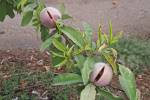Oleanders can tolerate drought, but needs lots of water
Q: I have had oleander trees for many years. Lately, they lose their leaves but one tree still look healthy. I water them every day in the summer. Is there any way I can bring them back to health again? I'm not sure these trees need lots of water or less water.
A: It is a misconception that oleanders do not need much water. We get this idea because they are very tolerant and can survive when there is not much water available.
As less and less water becomes available to them, they start to look bad. Usually they begin to drop their leaves and their canopies become very open. The nice thing is that when water becomes available to them they respond nicely, having survived a potential death blow and continue growing again, eventually becoming full.
Oleanders, contrary to some popular opinions, like to be watered deeply and about as often as you would water your shade trees. Watering every day is too often. At this time of year you should water them deeply about every three days. They enjoy a fertilizer application in the early spring and winter pruning, when necessary.
We try to avoid pruning them during their flowering period in summer. So, get your size control done with pruning during the winter months. If your shrub looks scraggly, then go ahead and prune out the tallest stems (usually the oldest and biggest in diameter) to the ground now as they will probably not look very good once the plant begins to show healthy growth.
These longer stems without many leaves will probably begin to bend toward the ground as vigorous growth resumes and the plant may look floppy. As you get this plant on its proper irrigation schedule you will want new strong, healthy and erect growth to come from the base.
Q: I'm having problem with roses and shrubs. The leaves turn brown and seem to have some sort of fungus. I have attached pictures for you to look at. I appreciate it if you could tell me what is the problem and possibly how to take care of it.
A: Thank you for the pictures; they were very helpful. This is what happens to roses frequently in our climate and our soils. The principle problem is a lack of soil improvement. It is also similar to a lack of water, so make sure each plant is receiving 2 to 5 gallons at each watering.
The leaves are scorching and the plant is dying back because the plant is losing its good health. This is most likely not due to insects or biotic diseases. Roses do not like our desert soils unless the soils are amended.
Amended soils are more similar to the soils where the roses originated. Soil improvement is a continual process that starts when the roses are planted and continues throughout their lives .
As the years go by, the amended soil begins to disappear and become more mineralized . Unless we continue to apply organic soil amendments and cover the soil with organic amendments that continually break down, desert soils will revert back to their native states.
I suggest that if these plants are more than 50 percent dead or dying you should replace them. Use plenty of compost mixed with our native soil when you replant them. Try to incorporate this compost into the surface of the soil around existing plants.
You can try applying some organic fertilizers and amendments around the plants, such as guano or composted manure. In late December, apply either some Miracle-Gro or Rapidgrow around the base of the plant. Also apply an iron chelate that contains the acronym EDDHA in the ingredients. Follow the label directions.
Apply an organic surface mulch that will continually decompose back into the soil. Use coffee grounds or used tea bags (without the bag) on the surface of the soil as well. Continue to replenish this surface mulch as it decomposes and work it into the soil. You will see improved plant growth and health and a dramatic change in soil color in the first one to two years.
Q: I live in Anthem and get a lot of strong winds. I've attached pictures of the multitrunk palo verde tree in my front yard, which has always done very well and still appears to be fairly healthy. It was a 24-inch box tree that was planted six years ago. Earlier this week, I noticed that the front part of it was leaning toward the street. Upon closer inspection, I saw that the trunk is splitting away from the rest of the tree. I raked away some of the rock mulch and saw several worms, so there must be many more down there. They don't look like the pictures of palo verde grubs that I saw online, but I'm sure they're causing damage to the tree, whatever they are.
A: The trunk is splitting at soil level and it looks like debris and soil has accumulated in the split.
I think what you are seeing is a splitting of the trunk at a narrow crotch angle. I can't tell for sure because the attachment at the crotch is at soil level or below ground. When trees have limbs that are poorly attached to a trunk they begin to weaken at this point as they get bigger and heavier. As it weakens, the poorly attached limb begins to split from the trunk.
The point of attachment of this major limb is so close to the ground it appears that soil and debris have accumulated on the top of the split. This accumulation of dirt and debris may have caused some decay in the limb and trunk.
I don't recognize the insect or worm in the picture. I don't believe it is damaging the healthy parts of the tree but is co-existing with the rotting parts of the wood. I think you would be fine if you just remove the limb that has split from the trunk, pull the soil away from the trunk and let it heal in the open air for a several days to a couple of weeks before replacing the soil against the trunk.
It will be a question of whether the loss of a major limb like that is going to be acceptable to you visually since the tree will be out of proportion for quite a long time.
Bob Morris is an associate professor with the University of Nevada Cooperative Extension. Direct gardening questions to the master gardener hot line at 257-5555 or contact Morris by e-mail at morrisr@unce.unr.edu.























